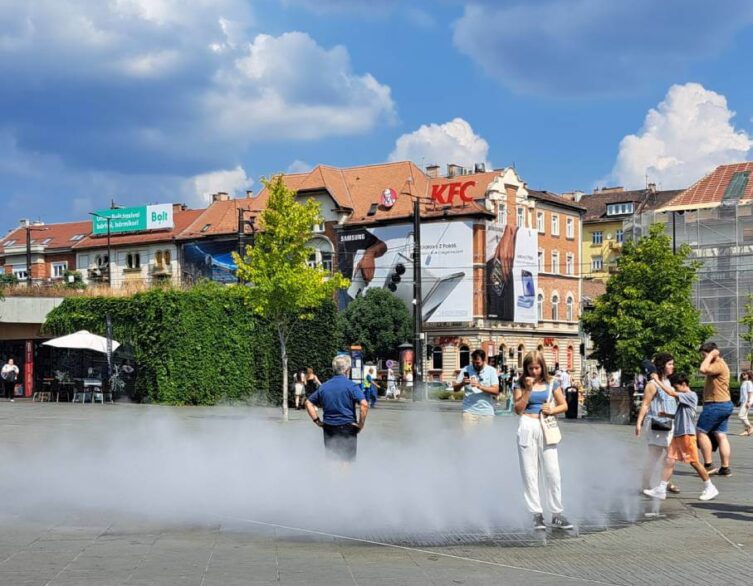Climate Change Affects Tourism Worldwide – And In Budapest As Well

Budapest, the capital city of Hungary, is already feeling the impacts of climate change. As global temperatures rise due to increasing greenhouse gas emissions, Budapest is experiencing changes in weather patterns, more frequent heatwaves, and other climate-related challenges. This article examines how climate change is affecting various aspects of life in Budapest.
Rising Temperatures and Heatwaves
Rising temperatures and heatwaves are already having a significant impact on tourism in Budapest, and this trend is expected to intensify in the coming decades as climate change progresses. The increasing frequency and severity of extreme heat events during the summer months is making the city less comfortable for visitors, especially for outdoor sightseeing and activities.
In recent years, Budapest has been experiencing more prolonged periods of scorching temperatures above 35°C (95°F). These oppressive conditions make walking around the city and visiting outdoor attractions very unpleasant and even dangerous for vulnerable groups like the elderly. Many popular tourist sites lack adequate shade or air conditioning. The intense urban heat island effect in the densely built central districts amplifies the discomfort.
Climate projections indicate that by mid-century, under a high emissions scenario, the number of climatically ideal days for urban tourism in Budapest during the peak summer months could plummet by over 50% compared to the present. July and August may become unsuitable for sightseeing. The tourism “sweet spot” will likely shift to the shoulder months of April-May and September-October.
However, if global emissions are curbed in line with the Paris Agreement goals, more summer days could remain in the comfortable range. Springtime city breaks in April-May and autumn visits in September-October would still be the most pleasant periods weatherwise.
Besides making conditions uncomfortable for tourists themselves, extreme heat also increases cooling costs and energy consumption for hotels, restaurants and attractions trying to maintain tolerable indoor temperatures. Warmer temperatures can impact food supplies and prices as well. Heatwaves put stress on infrastructure and disrupt transportation. Outdoor events and festivals may need to be rescheduled.
To adapt, the tourism sector in Budapest will need to make substantial investments in climate-resilient buildings, shaded spaces, cooling centers, heat alert systems, and green infrastructure to cope with rising temperatures. Marketing and promotion efforts will likely focus more on the spring and fall shoulder seasons. Indoor attractions and water-based activities may become more popular during heat spells.
However, unchecked climate change could make summer tourism in Budapest extremely challenging by late century. Only concerted global action to slash emissions can avert the most severe warming outcomes. The city’s tourism strategy must align closely with sustainability and adaptation imperatives. Careful planning is essential to ensure Budapest remains an appealing destination in a warming world.
Changes in Precipitation Patterns
In recent years, Budapest has experienced more frequent and intense rainfall events, especially during the summer months when tourism is at its peak. Heavy downpours can disrupt outdoor activities, such as sightseeing tours, cultural events, and recreational pursuits in the city’s parks and green spaces. Sudden rainstorms may force tourists to seek shelter, leading to overcrowding in indoor attractions and public transportation.
Furthermore, excessive rainfall can cause localized flooding, particularly in low-lying areas of the city. Flooded streets and sidewalks not only pose safety risks for tourists but also hinder their ability to explore the city comfortably. In extreme cases, severe flooding can damage infrastructure, such as roads, bridges, and public transportation systems, causing travel disruptions and limiting access to certain tourist destinations.
On the other hand, prolonged periods of drought can also adversely affect Budapest’s tourism sector. The city’s famous thermal baths, which rely on a steady supply of water, may face challenges during extended dry spells. Reduced water levels in the Danube River, a major attraction for river cruises and sightseeing, can disrupt boat tours and detract from the river’s visual appeal.
Moreover, changes in precipitation patterns can impact the city’s green spaces, parks, and gardens, which are popular among tourists seeking respite from the urban environment. Drought conditions may lead to withered vegetation and less vibrant landscapes, diminishing the aesthetic appeal of these outdoor spaces.
To mitigate the negative impacts of changing precipitation patterns on tourism, Budapest’s city authorities and tourism stakeholders must adopt proactive measures. These may include improving drainage infrastructure to minimize the risk of flooding, developing contingency plans for extreme weather events, and promoting indoor attractions and activities as alternatives during inclement weather.
Additionally, investing in sustainable water management practices, such as rainwater harvesting and water conservation techniques, can help ensure a stable water supply for the city’s thermal baths and other water-dependent attractions. Promoting eco-friendly tourism practices and raising awareness among visitors about the importance of responsible water usage can also contribute to the long-term sustainability of Budapest’s tourism industry in the face of climate change.
In conclusion, changes in precipitation patterns due to climate change pose significant challenges for Budapest’s tourism sector. By understanding these risks and implementing appropriate adaptation and mitigation strategies, the city can work towards building a more resilient and sustainable tourism industry that can withstand the impacts of a changing climate.
Impact on Urban Infrastructure
Climate change is having a significant impact on the urban infrastructure of Budapest, which in turn is affecting the tourism industry in the city. As temperatures rise and extreme weather events become more frequent, the city’s buildings, transportation systems, and utilities are facing increasing strain. This has implications for the comfort, convenience, and safety of tourists visiting the Hungarian capital.
One of the most noticeable effects of climate change in Budapest is the increasing frequency and intensity of heat waves during the summer months. With temperatures regularly surpassing 35°C (95°F), exploring the city’s outdoor attractions can become uncomfortable and even dangerous for tourists, especially the elderly and those with health conditions. The built environment, with its abundance of concrete and lack of green spaces in certain areas, amplifies this urban heat island effect. As a result, tourism during the peak summer season may shift to the cooler shoulder months of spring and autumn.
Transportation infrastructure is also vulnerable to the impacts of climate change. Extreme heat can cause rails to buckle and roads to soften and deform, leading to delays and disruptions in public transportation services that many tourists rely on. Flash flooding from heavy rainfall events can inundate streets and metro stations, making navigation difficult and posing safety risks. If these issues persist, tourists may opt for alternative destinations with more reliable infrastructure.
The city’s historic buildings and cultural heritage sites, which are major draws for tourists, are also at risk from the changing climate. More frequent cycles of intense heat and heavy rainfall can accelerate the weathering and deterioration of these structures, some of which are centuries old. Preserving these attractions will require significant investments in restoration and climate-proofing measures.
Best deals of Budapest
Recognizing these challenges, the municipal government of Budapest has developed a Climate Strategy and Action Plan to boost the city’s resilience and adapt its urban infrastructure to the changing climate. Efforts include expanding green spaces and urban tree cover to mitigate the heat island effect, upgrading the drainage system to better handle heavy rainfall, and retrofitting buildings to improve energy efficiency and thermal comfort.
In the long run, the tourism industry in Budapest will need to adapt to the realities of a changing climate. This may involve shifting the peak tourist season, developing more indoor attractions and activities, and promoting the city’s climate-resilient features as part of its appeal. By proactively addressing the impacts of climate change on urban infrastructure, Budapest can ensure that it remains a safe, comfortable, and attractive destination for tourists in the years to come.
Effects on Public Health
Climate change is having a significant impact on public health in Budapest, which in turn is affecting tourism in the city. Rising temperatures, more frequent heat waves, and deteriorating air quality due to climate change are posing health risks to both residents and visitors of Budapest.
As average temperatures climb and heat waves become more common during the summer months, the risk of heat-related illnesses increases, especially for vulnerable populations like the elderly and those with pre-existing health conditions. Prolonged exposure to extreme heat can lead to heat exhaustion, heat stroke, and exacerbate cardiovascular and respiratory problems. This makes spending extended periods outdoors sightseeing and exploring the city on foot during the peak of summer an uncomfortable and even dangerous prospect for many tourists.
The urban heat island effect further amplifies warming in the densely built-up city center of Budapest where many tourist attractions are located. The heat radiating from buildings and pavement can make the city feel much hotter than surrounding areas, reducing the appeal and comfort of visiting popular sites on scorching summer days. Tourists may opt to limit their outdoor activities or avoid certain exposed areas of the city during heat waves.
Air pollution is another public health concern that is being aggravated by climate change. Budapest already struggles with poor air quality, especially in terms of particulate matter. Warmer temperatures promote the formation of ground-level ozone, a major component of smog that can irritate the lungs. Increased ozone levels and more frequent air stagnation events could lead to more days with unhealthy air quality, triggering respiratory issues. Health warnings on high pollution days may deter tourists from spending time outdoors.
The spread of vector-borne diseases may also become a growing public health issue as the climate warms. Milder winters and expanding warm seasons could increase populations of ticks and mosquitoes that can transmit illnesses. While vector-borne diseases are not currently a major concern in Budapest, their increased prevalence in the future could make some tourists more apprehensive.
As public health risks related to heat and air pollution increase with climate change, Budapest’s city government and tourism industry will need to take adaptive measures. This includes improving the resilience of the urban environment through expanding green spaces, architectural changes, and heat action plans. Providing more indoor, air-conditioned spaces and activities for tourists during extreme heat will be important. Public health messaging aimed at visitors about coping with the heat and poor air quality days will also help tourists make informed decisions.
Overall, the increasing public health impacts from climate change may make summer tourism in Budapest more challenging and less appealing without interventions. Shifting the peak tourist season to the cooler shoulder months in spring and fall could be advisable. The city and tourism sector must prioritize adaptations and mitigation to protect the health of residents and visitors alike as the impacts of climate change intensify in the coming decades. Managing public health risks will be crucial for Budapest to remain a safe and attractive destination in the future climate.
Economic Impacts
Climate change is expected to have significant impacts on tourism in Budapest in the coming decades. As temperatures rise and weather patterns become more extreme and unpredictable, it will alter the attractiveness and suitability of Budapest as a tourist destination, especially in the peak summer months. This will have cascading economic effects on the city’s important tourism sector.
Some key economic impacts on tourism in Budapest related to climate change include:
Reduced summer tourism – Higher temperatures and more frequent heat waves will make summer visits to Budapest less comfortable and appealing for many tourists. The analysis suggests that by late century under a high emissions scenario, only a few days in July and August may be in the ideal temperature range for sightseeing. This could lead to reduced tourist arrivals and spending in the critical summer high season.
Shifting peak seasons – Spring (April-May) and Fall (September-October) are likely to become the most climatically suitable times to visit Budapest for city tourism. This will require the tourism industry to adapt marketing, staffing, pricing and operations to these shoulder seasons becoming the new peaks. Overall annual tourism may not necessarily decline, but will be redistributed.
Higher air conditioning costs – As summer temperatures soar, the costs for hotels, restaurants and attractions to air condition spaces for guest comfort will increase substantially. This may be passed on to tourists through higher prices or reduce profitability for businesses.
Pressure on urban infrastructure – More frequent heavy rains and heat will strain Budapest’s transport, energy, water and health infrastructure. Breakdowns and service interruptions could negatively impact the tourist experience and require costly upgrades.
Need for climate resilient investments – Tourist-facing businesses will need to invest in heat-resistant infrastructure and backup systems for essential services. This could include everything from heat-tolerant building materials to emergency water supplies. Financing these adaptation measures will be challenging.
Opportunities in shoulder seasons – The improved suitability of spring and fall for tourism does present an opportunity for Budapest to grow these seasons. With focused development and promotion, overall visitor numbers and revenues could be maintained.
In summary, without major emission reductions, climate change will make the peak summer tourist season in Budapest far less attractive, economically productive and logistically tenable by late century. Significant adaptation and shifting to a spring/fall-focused tourism model will be needed to reduce negative economic impacts. Cutting global emissions sharply can help preserve the viability of Budapest’s current summer-peak tourism economy. Either way, strategic planning and investments will be required to climate-proof Budapest’s critical tourism sector in the coming decades of change.
Conclusion
Climate change is already having a tangible impact on Budapest, and these effects are expected to intensify in the coming decades. Rising temperatures, changing precipitation patterns, and more frequent extreme weather events will pose challenges for the city’s infrastructure, public health, and economy. To build a more resilient future, Budapest will need to develop and implement comprehensive adaptation strategies that address these risks and ensure the well-being of its residents in the face of a changing climate. This will require collaboration between local government, businesses, and community stakeholders to create a sustainable and climate-resilient city.



















